To conquer death you only have to die. So tell us, oh great king of Nazareth, this Jesus Christ Superstar, do you think you’re what they say you are? Kensington Arts Theatre thinks that the Andrew Lloyd Webber and Tim Rice Broadway pop classic is worth using to open their 2015/2016 season upon the mainstage. Directed by Craig Pettinati with Musical Direction by Stuart Y. Weich, this rocker-classic retelling of the bible’s most infamous tale explores the relationships and motivations of Jesus’ rise to fame and how like in all celebrity existences too much fame can bring about a downfall of epic proportions. Sang with exceptionally strong talent, the KAT production is an aural gem that revitalizes and resurrects the sensational sounds of Webber and Rice with rewarding gusto.
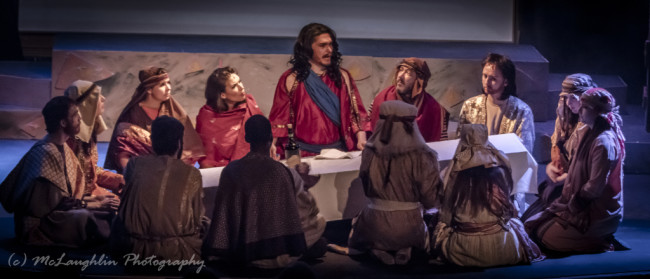
Going for the timeless biblical era approach, Set Designer James Raymond lays down a scenic construction that settles the audience right into the old bible stories of yore. With his two-story cavernous alcoves that appear to be the rocks of the holy lands, Raymond creates a fascinating play space for the actors, particularly with the two elevated alcoves flanking the stage on either side. The set is otherwise barren, a symbolic nod to the wasteland of souls Jesus has come to save. Multimedia Projections Designer John Nunemaker fills in the rest of the scenery with color-saturated imagery that enables the audience to go on a journey through biblical Jerusalem— inside and outside of the temple, to the court of Pontius Pilate, Herod’s Palace, and the streets of the city itself. Nunemaker’s subtle movement in the projected background creates a realistic feel to the scenery and his execution of fast sweeping animated constructs— to go quickly from outside the temple to inside of it— has a cinematographic feel to it.
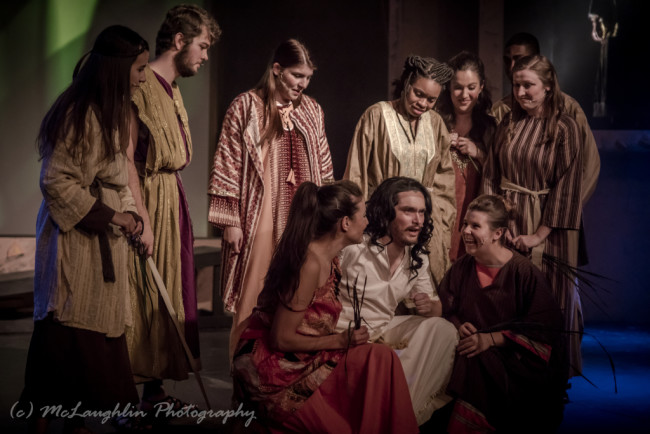
Nunemaker works alongside Lighting Designer Ryan Roberge to create striking moments of visual capture throughout the production. Nunemaker’s finest special effect comes from the shattering of the stained glass crucifix at the tail-end of the overture, while Roberge has many notable moments throughout the performance because of his intimate use of shadow and under-lighting. Flooding the jezebels of Jerusalem with bright white lights from beneath when they exist up in the elevated alcove creates a seedy and salacious image that haunts the background of Mary’s song, “Everything’s Alright.” This same shadow silhouette technique is deployed throughout the production by Roberge to create striking moments of emotional effect. Coupling these lighting cues with Nunemaker’s projections— particularly the silent field in the full moonlight for the Garden of Gethesemane scene— creates some of the most beautifully illustrated moments that occur in the piece.
The hallmarks of biblical classism are fully present in the Costume Design work of Eric S. Scerbo. Pontius Pilate is bedecked in the most regal of royal purple coloring, while the high city men of great self-import were gilded gold and fancier threads. The peasants, sinners, and lepers of the land reflect the tones of the earth in Scerbo’s vision of superstar couture. Scerbo makes a curious choice for Mary Magdalene with a dress that is an appropriate color but of an era that is ill-fitted by comparison to the rest of the costumes. This could be a loose symbolic interpretation that the world’s oldest profession transcends time, especially as Scerbo decks out Mary’s women in blinding gold lamé which is reminiscent of the era when the show itself was written.
Striking voices and powerful blends of full-force ensemble members are the show’s strongest suit, while its main faltering point is its dancing. Choreographer Nick Carter has several opportunities throughout the production where dancing— even of the most simplistic variety— could have been employed to fill space but is not. When the dance routines are executed, though they are extremely high energy and carried out with much enthusiasm, they look discombobulated and extremely repetitive. This is the case mainly during the title number and “What’s the Buzz.”
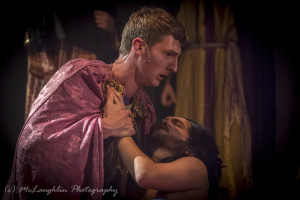
Musical Director Stuart Y. Weich handles the complexities of Andrew Lloyd Webber’s score with certainty. Showcasing a keen understanding of the awkwardly composed harmonies, Weich finds clever ways to mask some of the strange tonal blends that Webber has written so that they sound pleasant without being completely absent from the music. Guiding the ensemble to harmonious blends for larger group numbers like “Hosanna” and “Superstar”, Weich succeeds in delivering a musically impressive presentation of Jesus Christ Superstar. Director Craig Pettinati understands the limitations of his space and blocks accordingly, making exceptional use of the set constructed for him. Focusing on a singular slanted table, this lone prop becomes a universal focus of many scenes— including the last supper, which looks admittedly strange laid out on the leaning diagonal, but ties into the journey of this platform— allowing the audience to create a through line with its existence. What Pettinati is attempting to represent with the table is uncertain but its multi-purpose use displays his sharp ingenuity.
Unfortunately Pettinati overwhelms some of the grace and reverence of crucial scenes in the second act with his infusion of cast-encouraged wailing. During both “Trial Before Pilate” and “The Crucifixion” the ensemble is shrieking and moaning (and for the first number laughing and squealing shrilling) in such a manner that overtakes the orchestra and other singing that is happening on the stage. This detracts from the harrowing and tragic beauty of both of these numbers so intently that the scenes themselves become lost to the out-of-place garish soundscape created in those moments. Pettinati drives the play with bursts of energy, keeping true to the rock-and-roll format of Webber’s work. The overall outcome of the musical is impressive.
Soul Girls Allie Dreskin, Ashley K. Nicholas and Clancey Yovanovich are worth noting for their featured presence among the ensemble as they become Mary’s harlot dancers as well as King Herod’s Harem Girls. Dreskin, Nicholas, and Yovanovich provide delicious background harmonies for both “Everything’s Alright” and “King Herod’s Song.” Also worth mentioning as a featured ensemble member is Christopher Overly, doubling as Simon and Annas. Overly’s voice is most worthy of praise for his featured sounds in “This Jesus Must Die” and “Damned for All Time/Blood Money” providing a solid foil for Caiaphas.
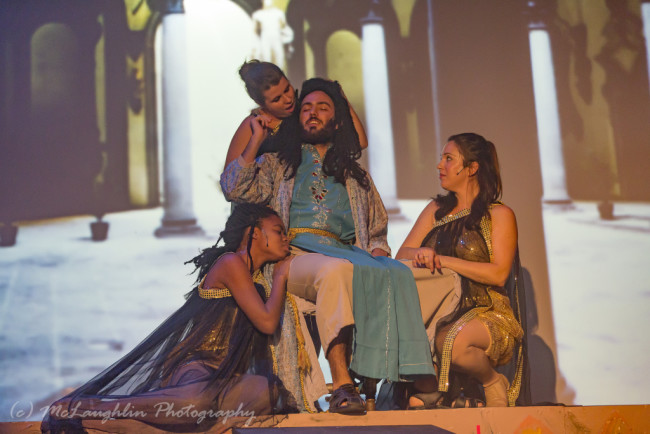
Gabriel Macedo takes on the despicable role of Caiaphas, doubling later in the show, albeit briefly, as Herod. Macedo possesses a deep voice which resonates quite soundly for “This Jesus Must Die.” Rich smooth vocals allow his villainous intent to echo through this song with ominous foreboding. Driven by fury at the end of this number, Macedo carries that violent energy into “Damned for All Time/Blood Money” at the end of the first act. Doubling as Herod, his ridiculously crass, albeit charismatic, nature radiates through “King Herod’s Song (Try it and See).” Delivering lighting quick quips throughout this number, Macedo brings back the old razzle-dazzle of musical theatre’s darkly twisted comic-relief tune in this song.
Reigning supreme as the most successful supporting performer in the production, Grant Saunders delivers a striking rendition as Pontius Pilate. His stature alone makes the character imposing, but the way Saunders carries himself with a purposeful regal air doubles that effect tenfold. With a stellar voice laying delicately into “Pilate’s Dream” it is more than evident that Saunders is the perfect casting choice for this role. The emotional depth that he stirs and creates for Pilate is astonishing, his reconciliation of vocal strength and emotional connectivity to the character’s tormented pathos sublime. “Pilate and Christ” as well as “Trial Before Pilate (39 Lashes)” are hauntingly beautiful and yet simultaneously torturously painful numbers that are carried by Saunders to the epitome of musical perfection. Anguished and stricken, Saunders delivers sheer and unabashed affliction, especially in the moment when he sings the line, “…I wash my hands…” one of the most powerful heart-stopping moments in the show.
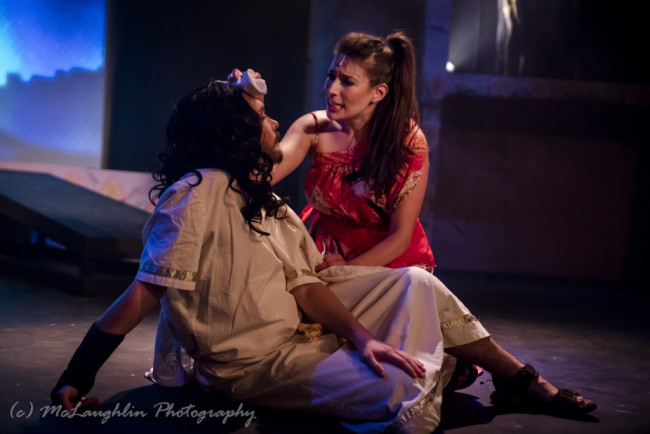
As the only credited female character, Kim Murphy brings a sensational vocal talent to the role of Mary Magdalene. Though her overall emotional connection to the character is lacking and often hollow, her voice is delivered with such force and modern-jazz intention behind it that you can easily forgive her acting missteps. Murphy’s voice is nothing short of a powerhouse echoing with pitch perfection for all of her featured solos and duets, especially “Could We Start Again Please?” a duet shared with Peter (Claxton J. Rabb III.) Murphy performs a lyrically beautiful rendition of “I Don’t Know How to Love Him” just before the end of the first act, her voice ringing out in a most angelic fashion.
Jesus Christ Superstar, a role fully actuated by Jesse D. Saywell, battles throughout the production with Judas (Ryan Burke) for leading male performer. Director Craig Pettinati draws focus to the emotional tensions between the two characters in a way that blatantly highlights the lover’s relationship between the characters, a remarkable and fascinating approach to the musical. The anger that spurs between them draws from the jealousies of unrequited love, Judas scorned by Jesus for Mary, Judas jealous of Jesus and his attention. Pettinati does an exceptional job of driving this concept home and the emotional catharsis in both characters is astonishing to the point of high praise because of this direction.
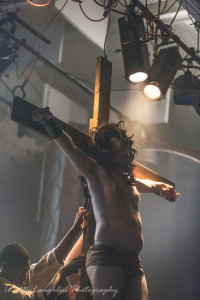
Saywell, as Christ, commands his moments on stage. The volatile exchanges between he and Burke throughout the performance, but especially during the end of “The Last Supper” is so biting and visceral that it palpates off the stage in waves. Saywell handles the ‘screamer-rock’ vocal segments of Webber’s songs with a mastery that showcases his range and talent. Displaying his versatility as a musical performer, “Gethsemane (I Only Want to Say)” is a raw and unapologetic delivery of fear, possessed by fury which starts simple and forlorn and crescendos into a harrowing 11th hour number. Handling the absurd syncopation in this number with great success, Saywell should be earmarked as highly talented for this song alone. Consistently carrying his anger and frustrations throughout the show, Saywell delivers a rough and rowdy Jesus that does the historical figure a great deal of justice.
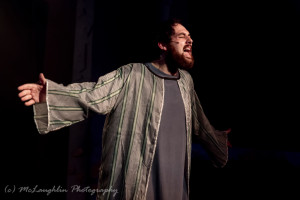
Wearing the crown of thorny emotions and masterful delivery is Ryan Burke as Judas. Carrying the emotional fortitude of the show on his shoulders, Burke is a living musical theatre titan upon the stage in this production. Vivacious and vibrant he eats through songs with a voracious appetite as if consuming each word he sings fuels the fire with which he delivers them. “Heaven on Their Minds” blasts the musical wide open with the immediate rocker-undertones required of the show when Burke lays into this opening number. Always at the top of his vocal power, Burke delivers a phenomenal series of emotional connections throughout that are ever changing, from blasting Mary with loathing and jealousy in “Strange Things Mystifying” to the soul-searing confession delivered in “Judas’ Death.” Versatile beyond just his singing, there are striking moments of acting— particularly the snatching and discarding of the silver coins in the Act I Finale— that make Burke’s performance truly amazing.
Compassionate, well-sung, and exceptionally well focused in regards to the messages being laid in the production, Kensington Arts Theatre delivers Jesus Christ Superstar to the level that is expected of such a legendary rock musical.
Running Time: 1 hour and 50 minutes with one intermission
Jesus Christ Superstar plays through November 21, 2015 at Kensington Arts Theatre located in the Kensington Town Hall— 3710 Mitchell Street in Kensington, MD. For tickets call the box office at (206) 888-6642 or purchase them online.

